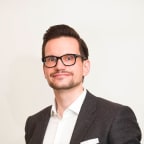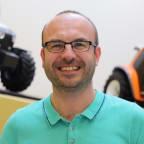TechLead-Story: Bernhard Fercher, Engineering Lead at Innerspace

Bernhard Fercher
Team
How large is the Dev/IT team? How is the team organized by roles?
Currently, we have 15 full-time members in development, divided into 3 teams – a design team and two cross-functional engineering teams collaborating closely.
The design team delivers concepts and storyboards, later developed into VR simulator modules. The disciplines of UX design, training design, and expertise from the pharmaceutical industry merge into ideas, flowcharts, concepts, and prototypes, closely reviewed and evolved with customers.
The two engineering teams have different focuses. One team creates end applications – VR simulators. This team combines game development skills to create, test, and release experiences. The team consists of a product owner, a scrum master, QA engineers, Unity developers, and 3D artists.
The second engineering team focuses on enablers, the technical developments necessary for certain features. Multilingual support, analytics, backend integration, and the entire tooling and internal libraries to enhance training development are among the topics. Maintenance and improvement of the CI/CD pipeline are also part of their responsibilities.
How is your team organized, and why did you choose a particular structure? What are the advantages and disadvantages?
We strongly align with the SAFe (Scaled Agile) Framework, allowing us to scale processes across multiple teams while maintaining alignment throughout the company. This ensures clear and transparent development direction. Daily stand-ups and bi-weekly sprint review meetings make individual contributions transparent, fostering a sense of teamwork.
What makes your team special compared to others?
Every team is unique, and at Innerspace, individuals with diverse backgrounds and skills come together to form a unique and multicultural team. Communication and collaboration are consistently highlighted in retrospectives, showcasing the team's forward-thinking and constructive approach. The intercultural mix adds a touch of humor to our team, spanning regions like India, Russia, Argentina, Latvia, Austria, Germany, and East Tyrol.
Recruiting
How is your department integrated into the recruiting process?
Candidates undergo a brief initial interview, followed by a second interview with an experienced developer or artist from the team, the future product owner, and myself. Successful candidates receive a small test project to objectively assess their technical skills. If the result is satisfactory, an offer is extended.
Is there a specific procedure for new colleagues? How are they integrated?
Onboarding is a multi-stage process. After a general introduction to Innerspace's philosophy, values, and products, new team members receive an onboarding checklist for which they take responsibility. For developers, technical onboarding includes "playing" all our VR experiences and concludes with the "merging" of their first pull request into the codebase.
Besides technical qualifications, what else do you value when looking for IT specialists for your team?
Communication skills! In remote teams, effective communication is crucial for team members, especially the product owner and scrum master, to be aware of current progress. Actively offering help and prioritizing team output over personal success are qualities we value highly.
Technologies
What technical challenges do you face?
The diversity and complexity of VR and game development, bundled into a robust, integrated enterprise solution for global pharmaceutical customers compliant with strict regulations, present significant challenges. VR, as a relatively new medium, requires finding interaction patterns tailored and simplified for our target audience – cleanroom operators. In VR training, there is no established blueprint, making this one of our core competencies.
What technologies do you work with?
Unity serves as the foundation for all our VR simulators. Around the VR applications, we have services for analytics, deployment, and interfaces based on modern web technologies such as Azure Functions, Node, and React.
How has the company's technology changed since its founding?
Founded in 2016, Innerspace initially focused on a web application for interactive first-person-view videos for learning from "homemade experiences." Soon after, VR became the cornerstone, with Unity as the preferred engine. The company's technological journey involves building and constantly evolving its own libraries for interaction systems, state management, etc. The current focus includes integrating VR training directly into clients' internal learning management systems, expanding the product offering with web services.
VR's rapid evolution promises immersive experiences with new devices, providing continuous excitement in shaping this medium and developing products for globally operating customers in critical production processes. As the saying goes, "If you can dream it, VR can do it."
Dev Interview Info

Bernhard Fercher
Lead Software Engineer























